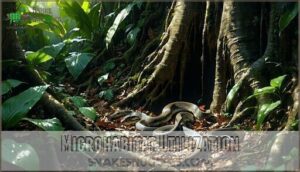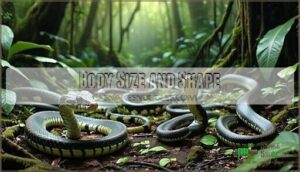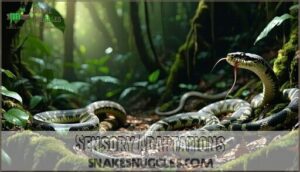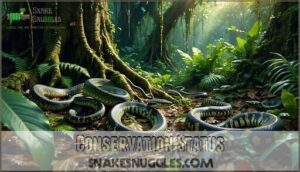This site is supported by our readers. We may earn a commission, at no cost to you, if you purchase through links.

The forest floor’s complex microenvironments create perfect conditions for countless snake species, from tiny thread snakes that slip between fallen leaves to powerful constrictors that hunt among rotting logs.
This hidden world supports both common species and rare endemics, each adapted to specific niches within the decomposing vegetation.
The warm, humid conditions and abundant prey make the jungle floor a snake paradise that scientists are still exploring.
What’s fascinating is how these serpents have evolved unique adaptations that help them thrive in this competitive underground ecosystem, with extraordinary levels of diversity, complex microenvironments, and unique adaptations that enable them to survive, making it a challenging yet fascinating environment to study, full of rare endemics and abundant prey.
Table Of Contents
- Key Takeaways
- Jungle Floor Snakes
- Habitat Preferences
- Ecological Roles
- Morphological Adaptations
- Conservation Status
- Frequently Asked Questions (FAQs)
- Which Africa has the greatest diversity of snakes in the world?
- What type of snakes live in the jungle?
- What are some facts about snakes in the rainforest?
- What is the most diverse family of snakes?
- How diverse are snakes?
- How many species of snakes are in the Amazon rainforest?
- What snake lives in the jungle?
- How do jungle floor snakes respond to habitat loss?
- What are the primary threats to jungle floor snakes?
- Are there any undescribed jungle floor snake species?
- Conclusion
Key Takeaways
- You’ll find incredible diversity – Over 60% of tropical forest snakes live on jungle floors, with some regions hosting 40-70 species per site, making these leaf-littered habitats true biodiversity hotspots.
- You’re looking at specialized survival masters – These snakes have evolved remarkable adaptations, like heat sensors, cryptic camouflage, and compact body shapes, that let them thrive in dense undergrowth and hunt everything from earthworms to small mammals.
- You’ll discover they’re ecosystem engineers – Jungle floor snakes fill crucial ecological roles as both predators and prey, using diverse hunting strategies, from ambush tactics to active foraging, while maintaining forest balance through complex food webs.
- You’re witnessing a conservation crisis – Habitat destruction threatens up to 78% of rare endemic species, while climate change forces snakes to retreat uphill, making protection of these fragile communities critical for preserving tropical biodiversity.
Jungle Floor Snakes
You’ll discover that jungle floors harbor an incredible variety of snake species, from tiny thread snakes barely thicker than a pencil to massive constrictors that can swallow prey larger than themselves.
From jungle floor shadows emerge nature’s most secretive predators, perfectly adapted for life in leaf litter.
These ground-dwelling serpents have mastered the art of camouflage, using leaf litter, fallen logs, and dense undergrowth to hunt everything from earthworms to small mammals while avoiding their own predators, showcasing their ability to thrive in a challenging environment with dense undergrowth.
Species Richness and Abundance
Jungle floor snake diversity presents a fascinating puzzle you’ll discover through careful study.
Species richness peaks at 40-70 snake species in Amazonian surveys, while Southeast Asian rainforests average 25-33 species per site.
You’ll find abundance patterns where just 3-7 dominant species account for 60% of individuals, creating clear richness metrics.
These biodiversity hotspots showcase remarkable ecosystem health through their tropical snakes and reptile diversity, making species diversity a key indicator.
Understanding the snake habitat in the jungle ecosystems is essential for conservation efforts and exploring species richness.
Dominant and Rare Snake Species
You’ll encounter both common and incredibly rare snake species on jungle floors.
Boas and pythons dominate most tropical regions, while specialized species like leaf-litter vipers remain elusive.
Snake distribution patterns reveal fascinating species interactions – some compete directly for prey, others avoid each other entirely.
Venom types vary dramatically among habitat specialists, from neurotoxic coral snakes to hemotoxic pit vipers.
Conservation efforts increasingly focus on protecting these hidden reptile diversity hotspots before rare jungle snakes disappear forever, which is a critical aspect of preserving reptile diversity.
Endemism and Biogeographical Patterns
Where do jungle floor snakes call home? Geographic isolation shapes snake species diversity across biogeography hotspots, creating unique distribution patterns through phylogeography processes.
- Amazonia dominates – Over 100 ground-dwelling snake species, with 60% found nowhere else
- Island effects amplify – Sundaland forests show 85% endemic species presence per patch
- Altitude creates boundaries – Distinct assemblages above 900 meters elevation
- Ancient barriers persist – River systems and refugia maintain separate evolutionary lineages
- Micro-endemics thrive – Some species restricted to areas under 50 km²
These ecological niches demonstrate how jungle floor habitat complexity drives remarkable biodiversity patterns.
Habitat Preferences
You’ll find jungle floor snakes thriving in remarkably diverse habitats, from dense evergreen canopies to surprising savanna clearings where moisture meets open ground.
These adaptable serpents don’t just pick any spot—they’re picky about their real estate, choosing specific microhabitats like fallen logs, leaf litter depths, and root systems that offer the perfect blend of humidity, temperature, and hunting opportunities.
Evergreen Forests
Most evergreen vegetation creates a humid microclimate that’s perfect for snake species diversity.
Dense leaf litter provides the perfect hideaway for jungle floor serpents to ambush unsuspecting prey.
You’ll find that the forest floor beneath dense tree canopy stays consistently moist, with thick leaf litter providing hiding spots.
This understory layer supports unique snake ecology patterns.
Forest ecology research shows tropical rainforest environments maintain stable temperatures year-round, allowing specialized serpents to thrive in these rich habitats.
The creation of suitable snake habitats often relies on proper snake habitat products, which is crucial for maintaining snake species diversity and supporting specialized serpents.
Savanna Enclaves
You’ll find that savanna enclaves create unique pockets where grassland dynamics meet forest edges, forming tree islands within tropical habitats.
These zones showcase fascinating snake species diversity through edge effects and island biogeography principles.
Snake ecology in savanna enclaves reveals:
- Specialized hunters adapted to both open grasslands and forest margins
- Thermal refuges provided by scattered trees for temperature regulation
- Prey concentrations where small mammals gather near vegetation boundaries
- Microhabitat complexity supporting diverse snake communities on the jungle floor
- Seasonal movement patterns following resource availability across savanna ecology gradients
Understanding bamboo forest ecology is vital for grasping the intricate relationships between snakes and their environments.
Coastal Restingas
Beyond savannas, you’ll discover snake species diversity thriving in coastal restingas—unique sandy shore environments.
These coastal ecosystems support specialized rainforest snakes adapted to dune vegetation and shifting substrates.
Restinga formation creates distinct microhabitats where tropical forest biodiversity meets ocean influence, fostering remarkable coastal biodiversity patterns.
| Coastal Feature | Snake Adaptation |
|---|---|
| Sandy substrates | Specialized locomotion patterns |
| Salt-tolerant plants | Modified prey selection |
| Shifting dunes | Enhanced burrowing abilities |
Microhabitat Utilization
You’ll discover snake habitat patterns through careful microhabitat analysis within tropical forest systems.
Snake denning occurs in specific Forest Structure niches – Tree Cavities house arboreal species, while Rock Crevice spaces shelter terrestrial ones.
Leaf Litter provides hunting grounds for small constrictors, and each snake distribution pattern reflects precise floor habitat requirements.
From moisture levels to prey availability across jungle ecosystems, these patterns are crucial for understanding snake behavior and ecology.
Ecological Roles
You’ll discover how jungle floor snakes fill essential ecological roles as both predators and prey in these complex ecosystems.
These serpents employ diverse hunting strategies, from ambush tactics to active foraging, while participating in intricate food webs that maintain forest balance.
Diet and Foraging Strategies
Once you understand where jungle floor snakes live, you’ll want to know how they find their next meal.
These hidden serpents have developed fascinating hunting tactics that make them incredibly effective predators in the tropical forest ecosystem.
Their feeding habits reveal remarkable diversity in prey capture techniques:
- Active hunters move through leaf litter searching for invertebrates and small mammals
- Ambush specialists wait motionless for up to 72 hours for the perfect strike
- Chemical trackers follow scent trails to locate hidden prey like earthworms
- Nocturnal feeders peak their activity between 7 PM and 2 AM
- Opportunistic feeders switch between insects and vertebrates based on seasonal availability.
Snake behavior changes dramatically with weather patterns.
During wet seasons, snake diet expands as amphibians become abundant. You’ll find that food chains in jungles rely heavily on these adaptable foraging behaviors, making each species essential to wildlife balance.
Predator-Prey Interactions
You’ll witness complex Predator-Prey Interactions as jungle floor snake species employ diverse Hunting Strategies.
These serpents use ambush tactics and chemical detection for Prey Capture, while potential victims develop sophisticated Predator Avoidance behaviors.
Species Competition intensifies when multiple predator types target similar prey, creating intricate webs that maintain Ecosystem Balance through natural population control mechanisms.
Understanding the importance of prey size guidelines is essential for the survival and well-being of these snake species in their natural habitats.
Niche Partitioning
Three different snake species can’t all hunt the same prey in the same spot—that’s where niche partitioning saves the day.
You’ll find jungle floor snakes dividing resources through spatial partitioning, with some preferring leaf litter while others stick to fallen logs.
Trophic specialization reduces resource competition as species target different prey sizes, enabling species coexistence despite overlapping habitats, supporting ecological diversity and species conservation efforts.
Morphological Adaptations
You’ll discover that jungle floor snakes have evolved remarkable body shapes and sizes to navigate their leafy world effectively.
Their cryptic coloration patterns and enhanced sensory systems help them hunt prey and avoid predators in the dim forest understory.
Body Size and Shape
Beyond feeding habits, jungle floor snakes showcase remarkable body adaptations for ground-dwelling life.
You’ll find these serpents perfectly built for traversing dense tropical vegetation with specialized snake morphology.
- Compact builds – Short, stocky bodies slip through leaf litter easily
- Flattened heads – Snake identification often relies on these wedge-shaped skulls
- Stubby tails – Tail lengths stay proportionally short for ground movement
- Overlapping scales – Scale patterns create flexible armor against rough surfaces
- Variable sizes – Body proportions range from pencil-thin to python-thick
Head shapes particularly help distinguish jungle floor species from their tree-climbing cousins.
The effectiveness of these adaptations can be seen in successful compact snake builds.
Coloration and Patterning
Across the jungle floor’s dappled light, you’ll discover snake identification becomes tricky due to intricate camouflage strategies.
Pattern evolution has crafted remarkable color morphs that mirror tropical vegetation perfectly. Scale texture creates visual signals through light reflection, while ecological biodiversity drives animal species toward specific adaptations.
Snake morphology varies dramatically, from earth-toned bands to leaf-like patches that fool predators completely.
Sensory Adaptations
You’ll discover that jungle floor snake species have developed remarkable sensory adaptations for their dark, cluttered environment.
Heat sensing helps pythons detect warm-blooded prey, while electroreception allows some species to sense electrical fields from muscle contractions.
Vision enhancement through specialized scales improves light detection. Scale sensitivity and vibrational detection through their bodies help these serpents navigate dense leaf litter and locate hidden prey in challenging ecological habitats.
The ability to use chemical radar systems plays a vital role in their survival and hunting strategies.
Conservation Status
You’re witnessing one of nature’s most pressing conservation challenges as jungle floor snake populations face unprecedented threats from human activities.
These ground-dwelling serpents, already masters of camouflage and secrecy, now struggle against habitat destruction, invasive species, and shifting climate patterns that threaten their specialized ecosystems, particularly due to human activities.
Habitat Loss and Fragmentation
You’ll find that habitat loss devastates jungle floor snake populations through fragmentation impacts and ecosystem disruption.
Deforestation effects create isolated patches where biodiversity loss accelerates rapidly. Snake conservation efforts face mounting challenges as forest habitats shrink continuously.
Critical fragmentation consequences include:
- Species richness drops 37% in isolated floor habitats
- Rare endemic snakes decline 78% in fragmented patches
- Dominant species crash 60% in smaller forest plots
- Genetic diversity falls 44% due to population isolation
Ecological fragmentation transforms once-continuous forests into scattered islands, making biodiversity conservation increasingly difficult for these hidden serpents.
Invasive Species
You’ll encounter invasive species threatening native snake communities through habitat competition and resource depletion.
NonNative predators disrupt ecological balance by preying on endemic species, while alien reptiles introduce diseases and parasites.
| Invasive Type | Ecological Impacts | Biological Control |
|---|---|---|
| Burmese Python | Reduces native prey populations | Removal programs |
| Cane Toad | Toxic to snake predators | Targeted trapping |
| Fire Ant | Destroys snake eggs/young | Pheromone disruption |
Species invasion creates cascading effects throughout jungle ecosystems, reducing species diversity and altering predator-prey relationships that native snakes depend upon for survival.
Climate Change Impacts
Climate change hits jungle floor snake species like a one-two punch.
Temperature shifts force these cold-blooded creatures to retreat uphill, while extreme weather and habitat disruption fragment their homes.
You’ll find up to 35% fewer species in warming areas, with carbon emissions driving this biodiversity crisis.
Sea level rise compounds the problem, threatening coastal populations and disrupting delicate ecological balance across tropical forests, driven by biodiversity crisis.
Research Methods and Sampling Techniques
Scientists use clever tricks to study these elusive forest floor inhabitants.
Mark Release programs tag captured snakes, tracking their movements and population health over time.
Camera Traps positioned strategically capture snake behavior without human interference.
Acoustic Monitoring detects species through unique movement sounds in leaf litter.
Statistical Modeling and Data Analysis help researchers understand biodiversity patterns in ecological ecosystems, making snake research more accurate and thorough for snake taxonomy studies.
The use of advanced camera trap systems has substantially improved the accuracy of snake population surveys.
Frequently Asked Questions (FAQs)
Which Africa has the greatest diversity of snakes in the world?
Your question seems to have a grammatical issue – you’re asking "Which Africa has the greatest diversity of snakes" but Africa isn’t divided into multiple regions in this particular case.
South America, particularly Brazil with over 400 snake species, leads global snake diversity. However, South America, Africa, and Southeast Asia are all known for remarkable snake diversity.
Africa doesn’t hold the top spot worldwide.
The continent’s snake population is often compared to snake species diversity found in other regions, which highlights the diversity of snakes in different parts of the world, including snake species.
What type of snakes live in the jungle?
Slithering through shadowy undergrowth, you’ll find venomous vipers, massive constrictors like pythons and boas.
Plus harmless species such as tree snakes, ground dwellers, and colorful coral snakes adapting to humid jungle environments.
What are some facts about snakes in the rainforest?
You’ll discover rainforest snakes are incredible hunters, using heat sensors to track warm-blooded prey in darkness. Many species climb trees expertly, while others swim through jungle streams with remarkable agility.
What is the most diverse family of snakes?
Like a snake shedding its skin, you’ll discover that Colubridae claims the crown as the most diverse snake family, boasting approximately 2,000 species across 249 genera worldwide.
This massive family includes your friendly neighborhood garter snakes and rat snakes.
How diverse are snakes?
You’ll find that over 3,500 species of snakes exist worldwide, making them incredibly diverse reptiles.
They’re found on every continent except Antarctica, adapting to countless environments from rainforests to deserts, showcasing nature’s remarkable evolutionary creativity.
How many species of snakes are in the Amazon rainforest?
You’re exploring nature’s library where chapters are written in scales and venom.
The Amazon Basin houses over 300 snake species, making it the world’s largest serpent sanctuary.
You’ll find everything from tiny thread snakes to massive anacondas coiled among the forest floor’s mysteries, showcasing the vast diversity of the region’s serpent inhabitants.
What snake lives in the jungle?
You’ll encounter various snake species in jungle environments, including pythons, boas, vipers, and coral snakes.
The reticulated python, mentioned in your knowledge base, represents one notable example living in Southeast Asian jungles.
How do jungle floor snakes respond to habitat loss?
You’ll adapt, migrate, or fragment your movements to survive.
Carpet pythons suffer from habitat destruction, losing suitable hiding places and shelter.
Snake responses to habitat changes occur on multiple scales with range contractions in the direction of distribution centers.
The survival of these species depends on understanding their python habitat needs, which is crucial for their survival.
What are the primary threats to jungle floor snakes?
You’ll face habitat destruction as the biggest threat, along with climate change, pollution, and invasive species competing for food sources in your shrinking jungle home.
Are there any undescribed jungle floor snake species?
In recent graveyards, biologist Alejandro Arteaga found Atractus zgap, a new yellow-bellied species.
Yes, you’ll likely discover undescribed jungle floor snakes since scientists find dozens annually worldwide, especially in remote tropical regions with dense forest canopies hiding secretive ground-dwelling species.
Conclusion
Spectacular serpent species showcase the remarkable jungle floor snake species diversity hidden beneath tropical canopies.
You’ve learned how these adaptable animals thrive in complex leaf-litter ecosystems, from tiny thread snakes to massive constrictors.
Each species fills specific ecological niches, displaying incredible morphological adaptations for survival.
However, habitat destruction and climate change threaten these fragile communities.
Protecting these biodiverse hotspots guarantees future generations can study and appreciate the extraordinary jungle floor snake species diversity that makes tropical forests true serpentine sanctuaries.















